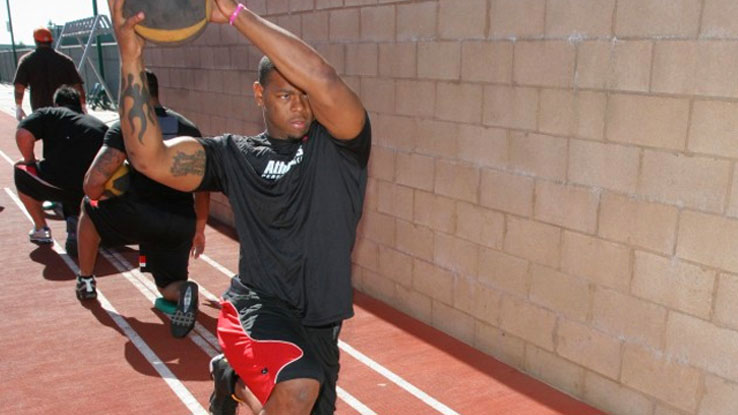Accomplishing a goal requires serious dedication and laser-like focus. Things like balance and down-time may sound appealing, but often aren't an option when victory is within your grasp.
Over the last 12 months, I'd been focused on one simple goal: to compete in a powerlifting meet.
I hadn't been on the platform in a while and I knew that if I was going to make it happen, it needed to be sooner rather than later. So I drilled down and dialed in.
And that focus paid off. My plan culminated in me competing in late 2011 – my first meet in six years – and I somehow managed to pull off an all-time PR with a 545-pound deadlift at 180.6 pounds.
However, a few things didn't go quite to design, and it weighed on my conscience.
First off, I was really light – I hadn't competed in the 181's since 2001. I knew I could get my numbers up quickly just by eating more and training hard.
And, being ever the student, I tweaked a few things with my squat and bench technique shortly after the meet that seemed to pay immediate dividends.
So, rather than taking time off, I jumped right back into the fire without giving my body the requisite time it needed to get right. It was a mistake, and my body soon began hinting that it didn't appreciate it.
I was getting other hints as well. It was now spring 2012, and spring is a notoriously bad time for training. I tend to travel quite a bit for speaking engagements, and hitting the gym for my own workouts becomes a lot more sporadic.
Lastly, I have a few other responsibilities in life.
I have a beautiful wife and daughter that I prioritize, two businesses that are both full-time gigs, outside work commitments, etc., so I simply got to the point that something had to change.
So injuries happen. Work happens. Life happens. Sometimes, life gets in the way of training.
If you're young and training is all you have to worry about, you probably think I'm a pussy. I'm okay with that, as I probably would've said the same thing 5-10 years ago. But if you're a bit older, you're probably nodding your head in agreement.
Granted, training has always been a great solace for me, but as the obligations and anxiety mounted, I realized the only way to get caught up would be to back off.
What ensued is what I call the Massive Maintenance Program.
I needed to be in the gym less, and while I knew I wasn't going to get bigger, stronger, or leaner, I could at least preserve the base and foundation that I'd been developing over the years while taking some things off my plate – and then, hopefully, come back bigger and stronger than ever before.
With that, here are some of the principles I used to define this type of training.
Minimal Training Days per Week
I've always trained either three or four days per week depending on my current goals, life obligations, etc.
But considering I was busier than ever, I decided to dabble with training just twice per week.
The benefit is obvious: you literally have one less day you're stuck in the gym. For me, that means an extra "block" where I can write blogs/articles/newsletters, shoot videos, record podcasts, etc.
The drawback, however, is that you have to be really smart about the exercises you choose and the focus of your program.
One thing I've found since cutting my training days to two is that I'm very dialed in on exercise selection.
All that extra random stuff you throw in when you have three or four days per week to hang and bang? Gone.
What you're left with are the big exercises that you absolutely have to keep in your program.
Of course, if you're training that infrequently, the popular upper-lower body split becomes obsolete. Hey, you're only hitting the gym twice a week – the least you can do is train your whole body when you do show up.
Always Lead Big
This should be self-explanatory, but we should always front-load our program with the biggest/most impactful exercises in our arsenal.
In the workout template at the end of the article, one of the following exercises should be your "lead exercise," unless you're working around an injury:
- Squat variation
- Deadlift variation
- Bench press variation
- Compound rowing variation
- Overhead press variation
- Chin-up/pull-up variation
Lay the Foundation
So you've hit a big bang exercise up front, now what?
The focus of a program like this should be to remember your long-term goals and lay a foundation for them going forward.
In my case, I want to get back on the platform sometime as I know I can hit some big PR's. So what I did was focus on things that might've been preventing me from moving forward, or stuff that I wouldn't want to spend time addressing when peaking for a meet.
That meant the not-so-fun things like mobility, stability, single-leg training, core development, and even breathing suddenly became the essentials, so I trained the heck out of them.
It's definitely not the same as preparing for a meet, so to make the most out of the change in focus it's best to adopt a "maintenance mindset," where any improvements in strength, physique, etc., are seen as a bonus.
It may seem like "selling out," but addressing your weaknesses or limitations will go a lot further towards setting up future success than always playing to your strengths.
A Sample Template
If this kind of programming jives with your needs or lifestyle, here's a basic template.
Now I hate cookie-cutter programs, so all I'm going to do is provide the exercise selections – the set/rep schemes, time under tension, and rest periods are all individual and must be tweaked to fit your specific goals.
Day 1
| Exercise | ||||
| A | Compound Lower Body Lift Examples: front squat, back squat, conventional deadlift, sumo deadlift, trap bar deadlift |
|||
| B1 | Posterior Chain Strength Examples: RDL, pull-through, hip thrust |
|||
| B2 | Horizontal Pulling Examples: bent-over row, low cable row, chest-supported row, dumbbell row |
|||
| C1 | Split-Stance Exercise Examples: split squats, lunges, Bulgarian split squats |
|||
| C2 | Horizontal Press Examples: loaded push-up variation, bench press variation |
|||
| D | Anti-Extension Core Exercise | |||
Day 2
| Exercise | ||||
| A | Compound Lower Body Lift Examples: front squat, back squat, conventional deadlift, sumo deadlift, trap bar deadlift. Pick the opposite pattern from Day 1. |
|||
| B1 | Accessory Posterior Chain Strength Examples: single-leg RDL, Swiss ball leg curls, glute-ham raise, single-leg hip thrust off bench |
|||
| B2 | Vertical Pulling Examples: chin-up variations, pull-up variations |
|||
| C1 | Single-Leg Exercise Examples: step-ups, chops/lifts, single-leg squats |
|||
| C2 | Vertical Press Examples: overhead pressing variation. If you have shoulder pain when overhead pressing, choose a push-up variation instead. |
|||
| D | Anti-Lateral Flexion Core Exercise | |||

Filling in the Gaps
If you're new to training twice per week, here are a few things to be aware of:
Stop eating so damn much!
While it may seem painfully obvious, remember that if you reduce your training volume, you also need to reduce your caloric intake. In the first month I put on about 5 pounds simply because I was still eating like I was training my ass off!
Once I recalibrated, I got things back under control, but it's human nature to have a "lag" with our caloric intake that can quickly catch up to us if we're not dialed in.
Find other ways to exercise.
I had two other realizations after moving to twice per-week training:
- My mood wasn't as great as usual.
- I had random aches that I can only attribute to decreased activity levels.
To help thwart both of these unwanted side effects, I try to get in some random exercise whenever possible.
- Take the steps instead of the elevator.
- Go for walks and/or bike rides with my daughter and wife.
These simple measures have made a big difference, and they couldn't be easier to include in even the most hectic schedule.
Summary
Now that I sound like an article you'd read in Prevention magazine, I'm going to try to wrap this up with what's still intact of my man-card.
Going from three or four training days per week to two isn't exactly fun or easy, especially when training is something you find enjoyable. And while I pulled a big deadlifting PR just six weeks into the program, it's still not something I want to do forever.
But if you're ever in a pinch, or find life kicking the piss out of your best-laid training plans, give this program a shot. Life isn't over just because you can't train exactly like you want. Chances are you'll come out on the back end bigger and stronger than ever!




